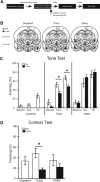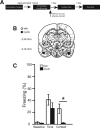The amygdala is critical for trace, delay, and contextual fear conditioning
- PMID: 25593295
- PMCID: PMC4341367
- DOI: 10.1101/lm.034918.114
The amygdala is critical for trace, delay, and contextual fear conditioning
Abstract
Numerous investigations have definitively shown amygdalar involvement in delay and contextual fear conditioning. However, much less is known about amygdala contributions to trace fear conditioning, and what little evidence exists is conflicting as noted in previous studies. This discrepancy may result from selective targeting of individual nuclei within the amygdala. The present experiments further examine the contributions of amygdalar subnuclei to trace, delay, and contextual fear conditioning. Rats were trained using a 10-trial trace, delay, or unpaired fear conditioning procedure. Pretraining lesions targeting the entire basolateral amygdala (BLA) resulted in a deficit in trace, delay, and contextual fear conditioning. Immediate post-training infusions of the protein synthesis inhibitor, cycloheximide, targeting the basal nucleus of the amygdala (BA) attenuated trace and contextual fear memory expression, but had no effect on delay fear conditioning. However, infusions targeting the lateral nucleus of the amygdala (LA) immediately following conditioning attenuated contextual fear memory expression, but had no effect on delay or trace fear conditioning. In follow-up experiments, rats were trained using a three-trial delay conditioning procedure. Immediate post-training infusions targeting the LA produced deficits in both delay tone and context fear, while infusions targeting the BA produced deficits in context but not delay tone fear. These data fully support a role for the BLA in trace, delay, and contextual fear memories. Specifically, these data suggest that the BA may be more critical for trace fear conditioning, whereas the LA may be more critical for delay fear memories.
© 2015 Kochli et al.; Published by Cold Spring Harbor Laboratory Press.
Figures





Similar articles
-
Elevated Arc/Arg 3.1 protein expression in the basolateral amygdala following auditory trace-cued fear conditioning.Neurobiol Learn Mem. 2013 Nov;106:127-33. doi: 10.1016/j.nlm.2013.07.010. Epub 2013 Jul 24. Neurobiol Learn Mem. 2013. PMID: 23891993
-
Contextual, but not auditory, fear conditioning is disrupted by neurotoxic selective lesion of the basal nucleus of amygdala in rats.Neurobiol Learn Mem. 2010 Feb;93(2):165-74. doi: 10.1016/j.nlm.2009.09.007. Epub 2009 Sep 18. Neurobiol Learn Mem. 2010. PMID: 19766728
-
Memory consolidation in both trace and delay fear conditioning is disrupted by intra-amygdala infusion of the protein synthesis inhibitor anisomycin.Learn Mem. 2011 Oct 25;18(11):728-32. doi: 10.1101/lm.023945.111. Print 2011 Nov. Learn Mem. 2011. PMID: 22028394 Free PMC article.
-
The role of basal forebrain cholinergic neurons in fear and extinction memory.Neurobiol Learn Mem. 2016 Sep;133:39-52. doi: 10.1016/j.nlm.2016.06.001. Epub 2016 Jun 2. Neurobiol Learn Mem. 2016. PMID: 27264248 Free PMC article. Review.
-
Different temporal windows for CB1 receptor involvement in contextual fear memory destabilisation in the amygdala and hippocampus.PLoS One. 2019 Jan 15;14(1):e0205781. doi: 10.1371/journal.pone.0205781. eCollection 2019. PLoS One. 2019. PMID: 30645588 Free PMC article.
Cited by
-
The central amygdala recruits mesocorticolimbic circuitry for pursuit of reward or pain.Nat Commun. 2020 Jun 1;11(1):2716. doi: 10.1038/s41467-020-16407-1. Nat Commun. 2020. PMID: 32483118 Free PMC article.
-
Age-Related Memory Impairment and Sex-Specific Alterations in Phosphorylation of the Rpt6 Proteasome Subunit and Polyubiquitination in the Basolateral Amygdala and Medial Prefrontal Cortex.Front Aging Neurosci. 2021 Apr 9;13:656944. doi: 10.3389/fnagi.2021.656944. eCollection 2021. Front Aging Neurosci. 2021. PMID: 33897408 Free PMC article.
-
Measuring human trace fear conditioning.Psychophysiology. 2022 Dec;59(12):e14119. doi: 10.1111/psyp.14119. Epub 2022 Jun 8. Psychophysiology. 2022. PMID: 35675529 Free PMC article.
-
From Bound Cells Comes a Sound Mind: The Role of Neuronal Growth Regulator 1 in Psychiatric Disorders.Exp Neurobiol. 2020 Feb 29;29(1):1-10. doi: 10.5607/en.2020.29.1.1. Exp Neurobiol. 2020. PMID: 32122104 Free PMC article. Review.
-
Combined administration of MK-801 and cycloheximide produces a delayed potentiation of fear discrimination memory extinction.Behav Neurosci. 2018 Apr;132(2):99-105. doi: 10.1037/bne0000232. Behav Neurosci. 2018. PMID: 29672107 Free PMC article.
References
-
- Amorapanth P, LeDoux JE, Nader K 2000. Different lateral amygdala outputs mediate reactions and actions elicited by a fear-arousing stimulus. Nat Neurosci 3: 74–79. - PubMed
-
- Bailey DJ, Kim JJ, Sun W, Thompson RF, Helmstetter FJ 1999. Acquisition of fear conditioning in rats requires the synthesis of mRNA in the amygdala. Behav Neurosci 113: 276–282. - PubMed
Publication types
MeSH terms
Substances
Grants and funding
LinkOut - more resources
Full Text Sources
Other Literature Sources
Medical
